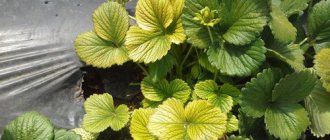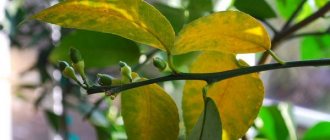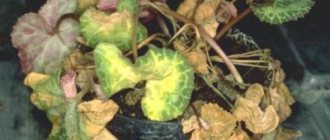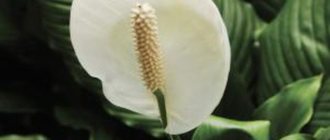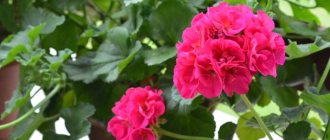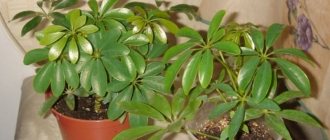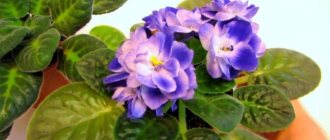Features of the flower
Most novice gardeners do not understand why the leaves turn yellow. This is due to the physiological characteristics of the flower or infectious diseases. The occurrence of physiological changes is observed with improper care. The appearance of infectious diseases can only be observed on plants that have weakened immunity.
Violet is an unpretentious indoor flower. This is why gardeners notice most problems late. It is recommended to carefully inspect the crop daily, which will make it possible to determine the cause of yellowness.
Violet foliage is collected in rosettes that have the correct shape. There are flowers in the center of the rosette. The leaves are characterized by a horizontal position. It shouldn't rise. If violet flowering is not observed, then the foliage should also be in a horizontal position. The leaves of the indoor flower are green in color, the shade of which varies depending on the type of crop. If, upon examination, the florist determines that his violet does not differ from this description, then he should not worry. If discoloration and dryness around the edges appear, it is necessary to evaluate the quality of flower care, as well as the presence of diseases.
Violet leaves can turn yellow for a variety of reasons. They can only be determined if the florist regularly inspects the flower.
Infectious diseases of violets
Infectious diseases include those that invade a weakened plant. Therefore, the cause of the disease is always improper care. In order to protect Saintpaulia from diseases, you should first of all not bring infection with new plants. Quarantine serves as a warning. The plant can be weakened by:
- non-compliance with thermal conditions;
- improper watering of plants:
- drafts, cold damp corner where the plant was placed.
Under such conditions, rot appears on the stems or roots of the violet, areas where late blight can penetrate. This is one of the most dangerous infectious diseases of Saintpaulia when temperature and humidity are not maintained. The causative agent of the disease is transmitted through the soil. Therefore, it is important to disinfect all purchased and homemade soil.
Another disease that can destroy all violets in a short time is called powdery mildew, which begins as a harmless dusty white coating and ends with the death of the plant. Powdery mildew on violets requires prompt treatment. You cannot take layering from such a specimen.
For treatment in the early stages, you can use special drugs such as Topaz or Saprol. As soon as you notice the powdery coating, cover the plant with sulfur powder, seal it tightly with a bag and create a temperature of 25 0 to kill the mycelium. You can spray it using a suspension of soda and laundry soap. If powdery mildew on a violet is severe, destroy the plant and carry out preventive treatment for the remaining inhabitants of the window sill.
The difference between infectious rot is that it spreads to all plants in cramped conditions. Non-infectious diseases can destroy one plant due to improper care.
Growing conditions
Violet needs optimal temperature and lighting. If the temperature changes sharply, this can lead to yellowing of the foliage. Violet must be grown at a temperature of 23-25 degrees. If the room is excessively cold or drafty, this can lead to stains. They negatively affect the appearance of the flower, but do not negatively affect health. In order to eliminate this nuisance, it is necessary to increase the temperature in the room. After a rosette appears on the flower, the yellow leaves are removed.
Excessively high temperatures are detrimental to the plant. This leads to softening of the leaf rosette and yellowing of the leaves. Extensive watery spots appear on the underside of the foliage. The upper part of the leaf turns yellow. If the room temperature is not lowered, this can lead to the death of the plant.
If the light is too bright, the leaves may turn pale. In this case, greenish-yellow foliage is observed, the edges of which curl upward. Violets do not tolerate excessively bright sunlight. That is why it is recommended to place them in partial shade. When exposed to solar radiation, not only yellowing of the foliage can occur, but also burns, which lead to tissue death.
The cause of the pathology may be improper organization of violet growing conditions.
Violet leaves turn yellow - what to do about it?
When yellowing just begins, the question arises whether it is necessary to treat immediately , or to first observe. The answer depends on the row of yellowed leaves - are they the lower ones or the younger ones?
Often the yellowing of the lower two rows is caused by the natural processes of the death of old, outdated leaf plates. In such a situation, the plant is monitored. If there is no yellowing on the upper rows, damaged leaves:
- Allow to die naturally;
- Or they are removed immediately (the advice of flower growers on this issue differs).
If the problem affects young sheets, or upon observation it goes higher and higher, you need to look for the cause . There are many reasons leading to this, and treatment directly depends on the diagnosis.
It is imperative to adjust the care if it was incorrect, and take treatment measures for this individual and preventative measures for the rest.
Important! Even yellowing of the lower rows, similar to natural processes, is often a signal of problems. if the loss of lower leaves is too rapid or uneven (the second row turns yellow faster than the first), treatment should be started.
Soil selection and replanting
Yellowing of violet leaves is often observed due to improper care. One of the very first reasons is thinned soil. This condition is also observed when the composition of the soil mixture is inappropriate. For violets, you need to choose slightly acidic, loose and light soil that has a high level of breathability. If plants are watered using hard water, this leads to the appearance of a large amount of alkali in it. Against this background, young leaves turn yellow and become discolored. If you do not replant the flower, the tips of the foliage will turn brown and dry out.
In order to avoid this problem, it is necessary to regularly acidify the soil. To do this, add vinegar or citric acid in a small amount to the water before watering. It is recommended to add high-moor peat to the container with settled water. With one gram of this product it is possible to reduce water hardness by 1 degree.
With the correct selection of soil during planting and proper watering, after a certain time, yellow leaves may appear. This indicates soil depletion. In this case, the plant receives insufficient nutrition. To eliminate yellowing, it is recommended to replant the plant. For this purpose, a nutritious soil mixture is used, which can be purchased at a specialized store. After transplanting the crop, it is fertilized. For this purpose, specialized fertilizers are used. If the violet is young, then this requires the use of a nutrient mixture that includes nitrogen and potassium. Feeding of adult flowers is carried out using phosphorus.
The grower must be careful when choosing a soil mixture, which will eliminate the possibility of yellowness appearing on the leaves.
Why do the leaves turn yellow?
At a blooming violet?
During the flowering period, violets often become a target for disease . Further actions after detection depend on the diagnosis. If the problem is care, then:
- It is being corrected;
- Then it is not necessary to remove the flowers (this depends on the complexity of the disease).
When the cause is infections and pests, further actions depend on the situation and the flowers are removed if replanting is necessary, but if everything is done by treating the leaves, then the flowers:
- Processed together with them;
- And they are kept under observation.
The leaves of a blooming violet can also turn yellow for various reasons.
If there is no reason for yellowing, and it catches the lower rows, this indicates a lack of strength . In this case, the plant needs to be fed urgently. Whether to leave flower stalks or not depends on:
- Socket status;
- And the number of lost leaves.
But do they retain elasticity?
Yellowed leaves are not always accompanied by a loss of turgor. If the plate remains elastic and the stems are not soft, and the color clearly does not match the variety, there can only be one reason - improper lighting . If the lighting is too bright, or from direct sunlight, the sheets lose color or get burned, but they do not always wither.
Along the edges, spots, streaks, streaks?
Uneven yellowing can cause a variety of problems :
By yellowing of the leaves, the cause of violet disease can be identified.
- Spots - burns, pests, powdery mildew;
- Along the edges - a lack of nutrients or moisture;
- Stains and streaks - excess fertilizers or salts in the soil, pests.
Advice! If yellowing occurs unevenly, it is better to immediately quarantine the plant; this is often a symptom of contagious diseases and pests. In this case, every day between other individuals increases the risk of infection of neighboring flowerpots.
Improper care
If the violet is not properly cared for, yellowing of the foliage may occur. Despite the fact that the flower is demanding of high humidity, spraying it is strictly prohibited. After this procedure, drops appear on the foliage that do not dry out for a long time. Ultraviolet rays are focused on them. In place of the droplets, yellow burn spots appear, which can have different shapes. Flower growers note the appearance of stripes, arcs, dots, shapeless blots, etc. on the foliage. The spots are characterized by a clearly defined local structure. After the spots appear, their further spread is not observed. The leaves themselves are strong. No color change is observed in this case.
Violet needs regular and abundant watering. It is strictly forbidden to allow the earthen clod to dry out, as this can cause yellow foliage. When the soil dries out, the leaf blades become pale and limp. If the flower is not watered further, the leaves will turn brown and fall off.
With excessive watering, rotting of the root system and stems is observed. Against this background, the violet foliage turns pale and yellow. In order to eliminate excessive moisture or drying out of the soil, it is recommended to use wick irrigation. It involves placing a thick cord in the pot that can retain moisture. One end of the cord must be passed through the drainage hole of the pot and placed in a container that is filled with water. In this case, watering of the drainage layer, as well as regular watering, is not carried out.
In order for the plant to fully grow and develop, it is necessary to regularly introduce nitrogen fertilizers in sufficient quantities. In order to ensure abundant flowering, phosphorus fertilizers are applied. If these rules are violated, yellowing of the foliage is observed. If you apply only phosphorus fertilizers to the violet, this will negatively affect its appearance. In order to ensure complete feeding of violets, it is recommended to use Emerald fertilizer. It is characterized by an optimal composition of microelements and is developed specifically for violets. In addition, this fertilizer protects the foliage from yellowing.
At the end of winter, a one-time feeding is recommended. In spring and autumn, fertilization should be carried out once a month. In summer it is necessary to fertilize the violet every week. Florists are recommended to alternate organic and mineral fertilizers. The first type of fertilizer is prepared from mullein or chicken droppings a week before the procedure. 100 grams of manure must be poured with a liter of water and left for 2 days. After this, the product must be filtered and diluted in three liters of water. Bird droppings are a more concentrated fertilizer. It is diluted at the rate of 20 grams per 3 liters of water. In order to eliminate the possibility of yellowing on the foliage, it is recommended to properly and promptly care for your violet.
How to prevent yellow leaves?
It is necessary to pay attention to the leaves of the flower when purchasing it. Often we do not notice the small spots of yellow or brown color and make a purchase in the confidence that the plant is healthy. But at home, the beginnings of the disease develop, and troubles begin.
To prevent the plant from getting sick, plant it correctly from the beginning. The pot must be new. But even if it is old, wash it before planting and then disinfect it. This will guarantee that the diseases of the old flower will not transfer to the plant you want to replant. Also, always use new compost. It is better if it is bought in a store. After all, such products undergo quality control and certainly do not contain fungi or pests. Well, the land that you can collect in the garden or in the forest is not immune from this.
Try not to place violets next to other plants, let them have their own place. This will prevent the transfer of diseases and pests from one flower to another.
Consider the characteristics of different varieties of violets. Plants with dark leaves like less light than those with naturally light leaves. Use this information when placing your flowerpot.
Adjust the watering and fertilizing regime to suit certain times of the year. In winter, the flower's needs decrease, and in spring, during the period of active growth, on the contrary, they increase.
Watch also the video, which tells about some of the secrets of growing violets.

